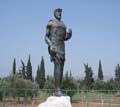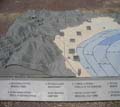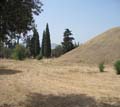
At the Tsepi site, an extensive cemetery of the early Bronze Age (3200 - 2000 BC). The tombs, built rectangular, were intended for multiple burials. Some are surrounded by a stone enclosure. The finds include marble figurines and pottery that reveal close relations with the Cyclades. They are exhibited in the Marathon Museum. At the Vrana site, burial mounds of the Middle Helladic era (2000 - 1600 BC). Three mounds with a horseshoe-shaped tomb in the center and a stone mantle around the perimeter, contained tombs with individual burials. The finds are exhibited at the Marathon Museum. A large vaulted tomb from the Mycenaean era (15th - 14th century BC) is preserved almost intact. It consists of a long road and chamber, where the pair of horses that pulled the funeral procession were also buried. At Plasi, a fortified Proto-Hellenic settlement (3rd millennium BC ) and a Middle Helladic settlement (2000 - 1600 BC), from which a building, a ceramic kiln and tombs were investigated. The decisive battle that took place at Marathon in 490 BC is well known. between the Athenians, with the support of the Plataeans, and the Persians. At the Soros site stands the burial mound of the 192 Athenians who fell on the battlefield (finds in the Marathon Museum). A second mound in the area of Vranas (near the Museum) is believed to contain the bones of the dead Plataeans. At the Soros site stands the burial mound of the 192 Athenians who fell on the battlefield (finds in the Marathon Museum). A second mound in the area of Vranas (near the Museum) is believed to contain the bones of the dead Plataeans. At the Soros site stands the burial mound of the 192 Athenians who fell on the battlefield (finds in the Marathon Museum). A second mound in the area of Vranas (near the Museum) is believed to contain the bones of the dead Plataeans.
Important sanctuaries existed in the area, such as Heraklion, in honor of Heracleus, and the sacred temple of Athena. In the area of the small marsh of Brexiza, a large sanctuary of the Egyptian gods (2nd century AD) with a monumental propylon and a temple was excavated. The finds in the National Archaeological Museum. Next to it was found a complex of baths with many areas of hot baths (2nd century AD). Both complexes were built at the expense of the wealthy philosopher Herod of Atticus (born and died in Marathon, 103 - 177 AD). At the site of Mandra tis Grias (Oinoi region) there is a precinct with ruins of various buildings that belonged to Herod's mansion (sculptures and inscriptions in the Marathon Museum). The Archaeological Museum exhibits findings from the burial mounds, caves and other monuments of the area.
At Marathon Lake, a three-aisled early Christian basilica on the site of the newer church of the Holy Trinity. Architectural members from the basilica built into the newer building.
Source: MINISTRY OF THE AEGEAN
media.yen.gr/atlas





